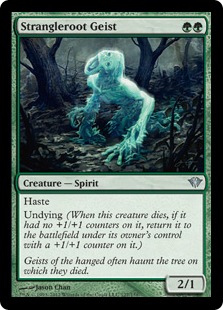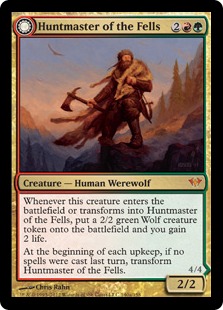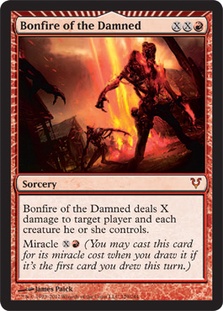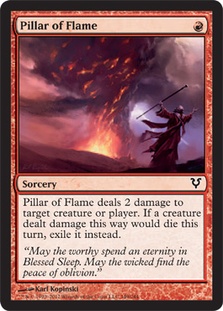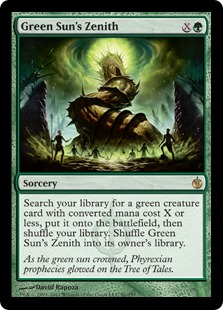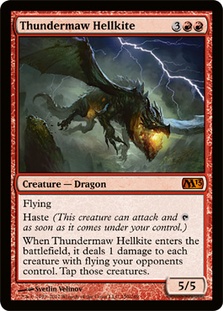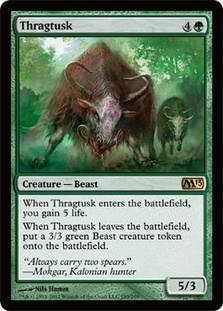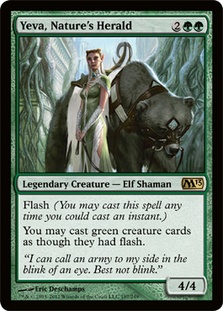Holy wow! Why hasn’t anyone talked about the actual best deck in Standard?
No, we’re not here to talk about Delver.
Occasionally this game we love, this game we call Magic becomes a complete hive mind incapable of breaking its own mold despite actually being right or wrong. That’s not to say that at any given time a particular person or group is wrong, but things do change and too often there are not many people branching out of the current hive mind.
In fact, it would appear that an extremely large majority of folks are completely convinced that Delver is the best deck, and it’s been reiterated countless times to the point that nearly everyone believes that it’s true.
I do not.
Creatures (23)
- 4 Llanowar Elves
- 4 Birds of Paradise
- 3 Borderland Ranger
- 1 Thrun, the Last Troll
- 4 Strangleroot Geist
- 4 Huntmaster of the Fells
- 1 Zealous Conscripts
- 2 Wolfir Silverheart
Lands (23)
Spells (14)

We aren’t here to blame anyone. If you know the market on rares, you can add up this deck and quickly realize that it’s the most expensive deck in Standard. Huntmaster of the Fells and Bonfire of the Damned both top at $20 apiece, Green Sun’s Zenith still holds value, and we’ve always known Sword of War and Peace and Sword of Feast and Famine as expensive cards.
The barrier to entry is multiplied by the lack of conversation about a particular deck; no one is incentivized to seek out these cards. Therefore, only a small percentage of people have access to the cards, and an even smaller percentage will sporadically decide to try G/R Aggro again when they are told by their peers that Delver is the best. These explanations also defend the point that often gets brought up: "Then how come it’s not winning any tournaments?"
Finance is often the number one barrier to entry, but being duped (I kid, I kid) into thinking it’s not even close to the best deck is a large wall to hurdle mentally.
Delver
When claiming something is the best (whether true or not), one must give reasons as to why. On top of that list is being able to beat the so-called best deck in the format—Delver.
The way Delver decks are currently set up will allow more aggressive decks to do what they do best: spew out cards to their heart’s desires and not worry about their creatures dying. At worst you can get out-tempoed by Vapor Snags on the draw or have your turn 1 mana dorks killed via Gut Shot. However, if your turn 1 play goes untouched, you’re hard pressed to lose the matchup at that point. This gets amplified by a follow up from one of your best creatures in the deck: Strangleroot Geist.
Strangleroot Geist comes out early and aggressive on the play and is fantastic on the draw against a Geist of Saint Traft. Neither Gut Shot nor Vapor Snag are optimal lines of play against Strangleroot Geist. Either Strangleroot comes back from undying or you follow him up with hasty attacks the next turn. Neither nets Delver very much in terms of winning the game.Â
In fact, Geist of Saint Traft being one of Delver’s better win conditions doesn’t do very much against G/R Aggro at all. From Huntmaster of the Fells forcing Delver to get out-card advantaged to Bonfire of the Damned able to nuke Delver’s entire board (and able to be hard cast easily), the amount of cards we play to combat their every move is very geared towards Delver decks. One caveat is the fact that Blade Splicer variants are a little harder to attack and defend against.
Delver’s best card game 1 against us is Restoration Angel, so be aware of that. Often, attacking with a Strangleroot Geist or any other creature with a backup Kessig Wolf Run is a good way to deal with the Angel flashing in to block you.
Out of the sideboard the matchup gets worse for them. Depending on what variant they are playing you can bring in Crushing Vines, which deals with multiple cards of theirs. Extra Green Sun’s Zeniths help you hit more Strangleroot Geists and Huntmaster of the Fells, which as mentioned earlier are the cards you are looking for against them. Thrun is also naturally strong against Delver, whereas your five-drops are underwhelming and unnecessary, so cut them for the aforementioned cards.
Remainder of the Field
To be the best deck you not only have to beat other top tier decks, but you also need to beat the majority of the field. G/R Aggro is a consistent deck that is most often the beatdown deck, but it can flip a switch and play a control or midrange style game if needed. Huntmaster of the Fells is the reason it’s possible to play on both ends of the spectrum, as is Bonfire of the Damned.
Consistency is the reason Delver is a clear choice for most players, and G/R Aggro is no different. The consistency of its game plan is on par with that of Delver’s, but it can cast even more powerful spells, albeit at sorcery speed. Cards like Pillar of Flame excel against anything except control matchups (even though you can do two damage to the dome). This is true for Bonfire of the Damned, but with Bonfire you can have complete game flips and blowouts in any kind of creature matchup. Miracling a Bonfire of the Damned midgame is game ending an extraordinary amount of the time, even against control.
Huntmaster of the Fells, Strangleroot Geist, Swords, and Green Sun’s Zenith are all incredibly powerful against the field. Turn 2 Sword or Strangleroot Geist puts control decks on their heels quickly. Swords and Huntmaster are fantastic against other creature decks, and when you combine all the support cards the deck provides, you get a consistent game plan against anything you are sitting across from. Sideboarding also feels favorable as there aren’t many cards that destroy you like there are for Zombies (Celestial Purge). And the cards you bring in cover so much of the field that sideboard choices are generally clearer than most decks and also feel like a relevant upgrade going into games 2 and 3.
In fact, there isn’t a single deck that feels like you are fighting an uphill battle; a feeling that is fairly rare from my experience. With Delver there seems to be plenty of decks that have its number, including Zombies, Tokens, Frites, G/R Aggro, and any other number of rogue decks that want to target it. The thing is, only Zombies and G/R Aggro have game against the field, and this has been proven as we saw B/U Zombies take down the SCG Standard Open in Detroit just a week ago.
As mentioned earlier, just be wary of Blade Splicer, as the first strike is very hard to attack into. Ratchet Bomb has quite a bit of game against Blade Splicer decks since it hits fairly hard when you slow roll it and they don’t expect it. Just be aware of your own Huntmaster tokens.
The Future is Bright
As you all know, we are on the verge of putting yet another set into our Standard environment. Being a core set isn’t often enough to change a deck too drastically, but despite already being the best deck in the format, G/R Aggro is getting quite a few toys.
Actually, not toys…machines!
Rancor is the obvious inclusion, and there’s no way a green-based aggro deck won’t run it. Eventually, other decks will catch on and Blade Splicer will become even better, as will cards like Thalia and maybe even Porcelain Legionnaire, but Rancor is still a card you will leave in your deck because it’s going to be one of the more powerful Spells in standard for quite some time. However, Rancor isn’t the only card that could end up in G/R Aggro; how about Thundermaw Hellkite!
It really depends on where the metagame ends up, but Thundermaw Hellkite as a one- or two-of alongside Zealous Conscripts and Wolfir Silverheart are some serious game enders. The bonus with Thundermaw Hellkite is that he clears the way for any of your creatures on the ground, which will often be game over. Haste is a reason G/R Aggro can dominate so well; even pseudo haste like soulbond and Sword plus equip can end up being a game ender. Speaking of haste, Flinthoof Boar is another card that could end up in G/R Aggro. The only issue is the lack of Mountains the deck currently plays. And, of course, we are also getting Thragtusk, which is another good target for Green Sun’s Zenith.
And finally, perhaps the biggest game of all—Yeva, Nature’s Herald. What excites me about Yeva is the fact that you can sit on Huntmaster of the Fells, allow it to flip, and then cast another 4/4 on your opponent’s end step; this leaves you open for all kinds of follow up plays.
Come M13’s release, here is a list to begin with:
Creatures (20)
- 4 Llanowar Elves
- 4 Birds of Paradise
- 1 Thrun, the Last Troll
- 4 Strangleroot Geist
- 4 Huntmaster of the Fells
- 1 Zealous Conscripts
- 1 Wolfir Silverheart
- 1 Yeva, Nature's Herald
Lands (23)
Spells (17)

Besides Rancor, the decisions may or may not be correct but are worth testing the waters with as they don’t change the deck too much. Borderland Ranger has been great for consistency; however, with Rancor you can work on a lot less mana and still get in relevant damage quickly.
Play around with decks, proxy decks: do what it takes. Finding that sweet spot of a deck you both love and can put up actual results with is important. G/R Aggro, to me, is quite clearly the best deck in Standard right now. There are similar decks such as Naya Pod that are close, but the consistency and aggressiveness that comes from all angles with G/R Aggro puts it into the clear lead for me.
There may be irony in the article title—but don’t believe the hype! Most players aren’t capable of putting up relevant win percentages with Delver because of how difficult it is to play. Find your sweet spot, and you will win more.

